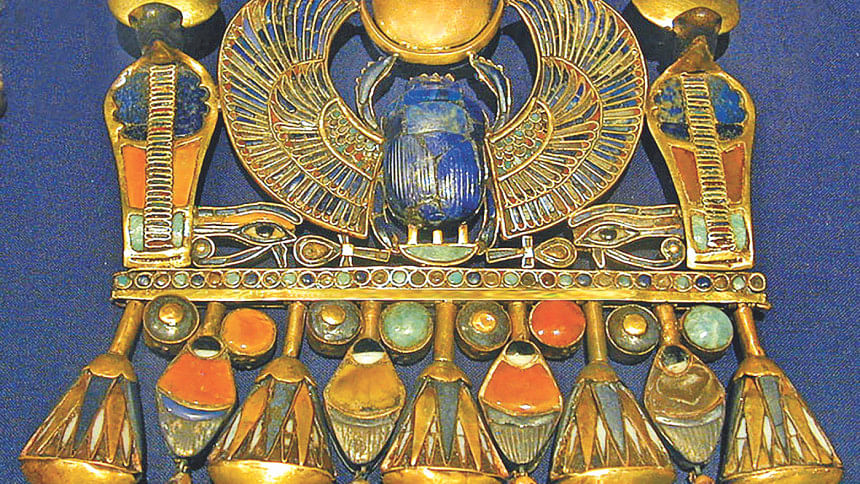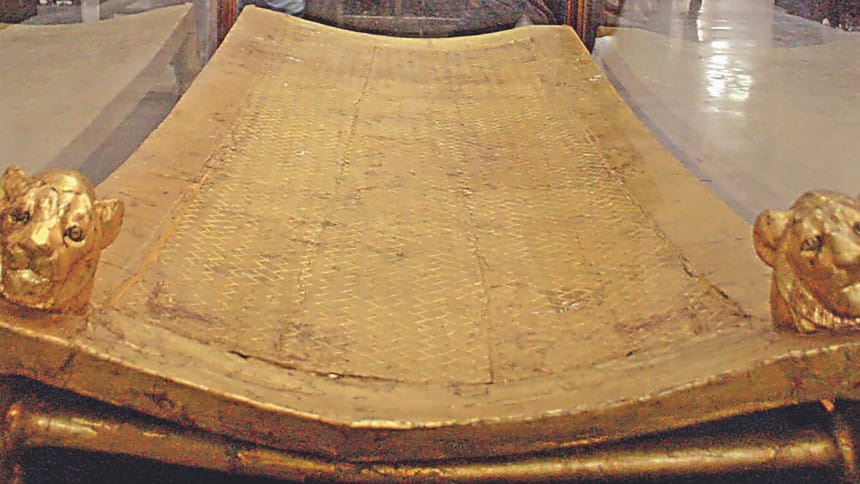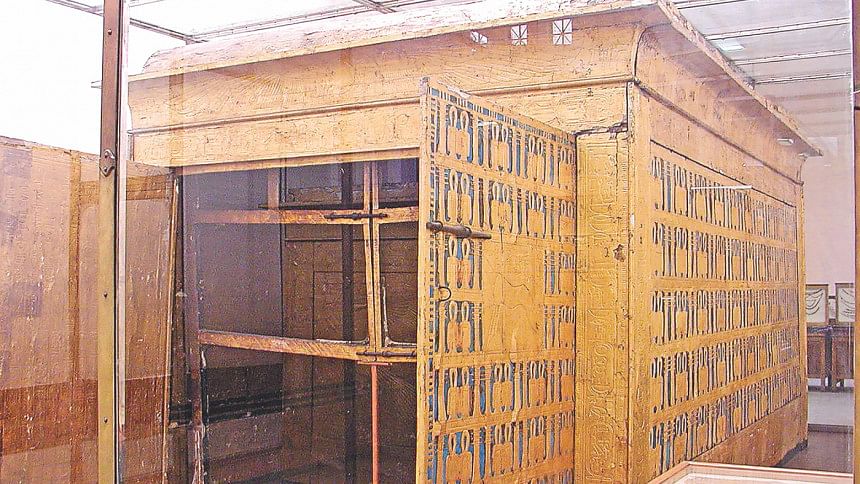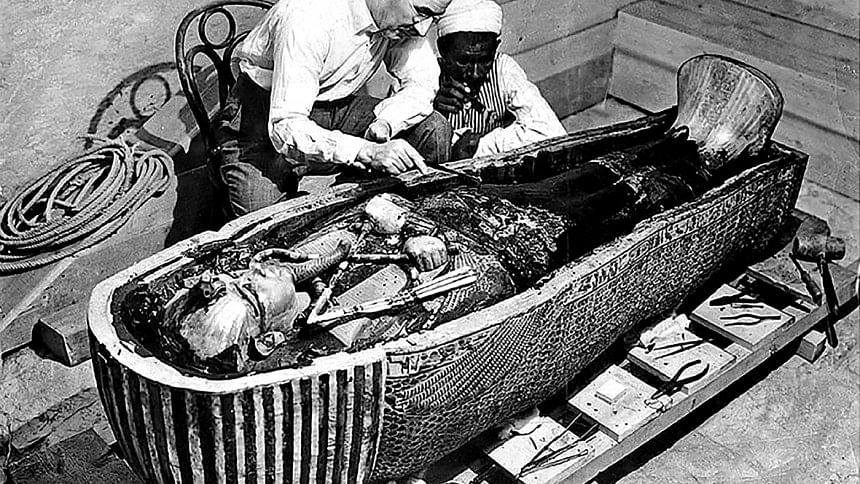The Treasure of Tutankhamun

Tutankhamun is probably the most famous king of the age of antiquity in the modern world. A teenage pharaoh of the 18th dynasty of the ancient Egypt, who started to rule the Egyptian kingdom at the age of nine when Egypt was at its golden age, managed to rule only 11 years and died at the age of 19. Born in 1341 BC (Before Christ) in the family of a famous pharaoh Akhenaten, he is a historical character in modern times, not because of his rule or any other outstanding creation of his time but for the discovery of his tomb at the Valley of the Kings in Luxor. His tomb was found entirely intact with more than five thousand objects mostly made of gold.
Another world-famous historical character was Queen Nefertiti, the step-mother of Tutankhamun. His own mother known as 'The Young Lady' was a sister or cousin of his father Akhenaten. The young king suffered from various diseases, failed to enjoy a long regime, died in 1323BC at the age of 19, left no king or queen from his family as both of his daughters died as infants, his wife Ankhesenamun got married with his Grand Vizier 'Ay' and Ay succeeded as the king of Egypt.

Within the 19th century AD, all the tomb and mummies of documented major kings were discovered at the Valley of the Kings in Luxor except the tomb of Tutankhamun. It was a great puzzle for the Egyptologist from the late 19th- early 20th century as many attempted to discover his tomb but it still couldn't be found. An aristocrat of Great Britain Lord Carnarvon, who was a curious enthusiast of the ancient Egyptian pharaohs, deployed and financed British Egyptologist Howard Carter to search the tomb of Tutankhamun in 1914 at the Valley of the Kings in Luxor. No result was found for the next eight years of continuous search of Howard Carter and his team; in 1922 Lord Carnarvon decided to stop financing and stopped the project at the year end. Carnarvon's decision made Carter's team desperate to search for the tomb of Tutankhamun. Carter's team was concentrating on a line of huts that Carter had left excavating a few years back. He had cleared the stone debris, yet with no result. Fortunately, on November 4, 1922, one of the water boys of the excavation team accidentally slipped on soft rock and broke it, which opened the staircase of a hidden tomb. Carter immediately started to excavate and removed the debris of the steps and reached the doorway of the tomb. The doorway was inscribed with royal cartouches (an oval seal bearing the name of king in hieroglyph writing), and Carter miraculously found the doorway of the most cherished tomb that he was searching for the previous nine years. He instantly sent a telegram to Lord Carnarvon in UK to come to the site as soon as possible and waited for his arrival. On November 22, 1922, Carnarvon arrived on the site from London. With the presence of the officials of the Ministry of Antiquities of Egypt and Lord Carnarvon, Howard Carter opened the door of the tomb. The opening was filled with objects made of gold; it was yet to be confirmed if it was really the tomb of the young king. It took four months to document all the objects in the antechamber. In February 1923, Carter opened the sealed doorway inside, found the burial chamber and got the first glimpse of the long-expected sarcophagus of Tutankhamun. The discovery of the tomb of Tutankhamun and its intact gold treasures got worldwide media attention and created a craze and mystery among the people worldwide. In total, 5,398 objects were finally collected from the tomb of Tutankhamun, mostly made of gold and took a painstaking 10 long years for Howard Carter to complete the documentation.

Howard Carter opened the coffins and removed the ornaments from the mummy of Tutankhamun in such a way that it would be completely impossible to preserve the mummy outside of the tomb. The mummy of the young king left at the tomb makes it the only royal tomb of ancient Egypt containing its royal mummy inside. The common practice was to bring the mummies to the museums after the discovery of the tombs. But all 5,398 objects of the tombs were brought to the Egyptian Museum in Cairo. At present only one-third of the objects are on display of the museum but soon they will be transferred to the newly constructed Grand Egyptian Museum near Giza Pyramid where the authority is planning to put on display all the objects discovered from the tomb, expected to be opened in 2020.
Ancient Egyptians believed in an afterlife and it was the norm to mummify their bodies and keep all their belongings with their tombs. That's why the tomb of the kings and queens were often filled with exclusive valuable objects made of gold, alabaster and other valuable materials to use those in their afterlife. As a result, ancient Egyptian tombs were always a target for robbers. Though there is evidence that the tomb of Tutankhamun was robbed at least two times, not long after he was buried, yet remained intact because of its position in the Valley of the Kings. His tomb was not a royal tomb in its size, in the true sense, the smallest among all the tombs of the kings and it was just beside the tomb of Ramesses the 6th. Moreover the existence of a worker's hut above the tomb of Tutankhamun facilitated to forget the existence of the tomb. As a result it was mostly safe from the robbers and nobody found this tomb before the discovery made by Carter in 1922. The recent medical investigation of the mummy of Tutankhamun has revealed that he was suffering from malaria and Kohler; he also had a broken leg that was infected. The theories suggest that he died suddenly and because of his sudden death at a very young age, it wasn't possible to make a tomb dedicated to him. He was probably buried in a tomb which was made for someone else. Some recent research suspects that he was probably buried in an extensive portion of the tomb of the famous queen 'Nefertiti' and most of the belongings of the tomb of Tutankhamun actually belonged to Nefertiti; the tomb of Nefertiti is yet to be found.

Among the objects found from the tomb of Tutankhamun are gold and stone made jewellery, chariots, chairs, couches, canopies, thrones, headrest, funerary ritual bed, four gilded burial shrines, solid gold and gilded coffins, gilded statue, weapons, funerary objects, jars, sticks, solid gold mask, musical instruments, scribal instruments, clothes and thousands of ornaments. Along with such objects, 48 wooden boxes of mummified meat and 30 jars of wine were also found. Among all the discovered objects and items from the tomb, the most famous is the death mask of Tutankhamun which is 21 inches long and 15 inches wide. The death mask was made of 10kg of solid gold inlaid with semi-precious stones, currently standing as the main jewel of the Tutankhamun collection display at the Egyptian Museum Cairo. This mask is one of the best-known objects of ancient Egypt.

The golden throne is another fascinating object found in the tomb. The throne is made of wood, covered with a layer of pure gold and decorated with semi-precious stones, another best known symbolic object of ancient Egypt, a testament of the highly skilled craftsmanship of ancient Egyptians. In the middle of the throne, there is an illustration of a scene of Tutankhamun and his wife Ankhesenamun where his wife is pouring perfume on the shoulder of the king. An Anubis shrine made of wood and partially gilded painted in black is one of the many other large funerary objects that have been found.
The burial shrine of Tutankhamun consisted of wooden made gilded boxes placed one inside another. In the innermost shrine, there was the sarcophagus made of red quartzite. The sarcophagus was contained with three anthropoid coffins one inside another. The first two coffins were made of gilded wood but the final one was made of solid gold. The mummy of Tutankhamun was kept inside this solid gold made coffin covered with the gold mask and other thousands of jewellery pieces. The mummy was wrapped with linen layers; pieces of jewellery, armour, and daggers were kept in each layer of wrapping. There are also canopies containing the internal organs of Tutankhamun. Except the mummy and the sarcophagus, most of the objects can be seen today at the Egyptian Museum in Cairo.
The discovery of the tomb of Tutankhamun created a worldwide phenomenon that many developed countries started negotiation with the Egyptian government to make an exhibition in their respective country. American President Richard Nixon made requests personally during his visit to Egypt to the Egyptian President Anwar Sadat to allow the objects of Tutankhamun to travel to US for exhibition. Till now only UK, US, Canada, Russia, Germany, Japan, Austria, Switzerland, Australia, and France have managed to convince the authority and arranged temporary exhibition of the objects of Tutankhamun which makes the objects of the tomb of Tutankhamun as the most traveled artifacts of the world. The exhibition titled 'The Treasure of Tutankhamun' ran from 1972-81 in UK, US, Canada, West Germany, and USSR, became the most popular exhibition in the museum history. This exhibition single-handedly attracted 1.6 million visitors in UK and over eight million visitors in the US.

A common rumour or superstition exists about the tomb of Tutankhamun, commonly known as 'The Curse of the Pharaoh'. It was a common belief that disturbing the tomb of the pharaohs will bring severe illness, bad luck and even death, originally a rumour to protect the tombs from the robbers. But in the 20th century, the death of several people who were involved with the excavation of the tomb of Tutankhamun seemed to corroborate such superstition. At least 11 people associated with the discovery of the tomb of Tutankhamun died within 10 years of discovery of the tomb. Especially, the death of the financer of the project Carnarvon four months after his visit to open the tomb strengthened the superstition of the curse of the pharaoh which later got popularity by media attention, tv-series, science fiction, and novels. Still today, the tomb of Tutankhamun, known as KV62 at the Valley of the Kings in Luxor is open to the public. The sarcophagus, the coffin and the mummy itself have been kept inside the tomb and everyday a huge number of visitors enter the tomb to experience inside without getting terrified by the superstition of the curse.
Mohammad Abu Al Hasan is an archaeologist and heritage professional.

 For all latest news, follow The Daily Star's Google News channel.
For all latest news, follow The Daily Star's Google News channel. 



Comments